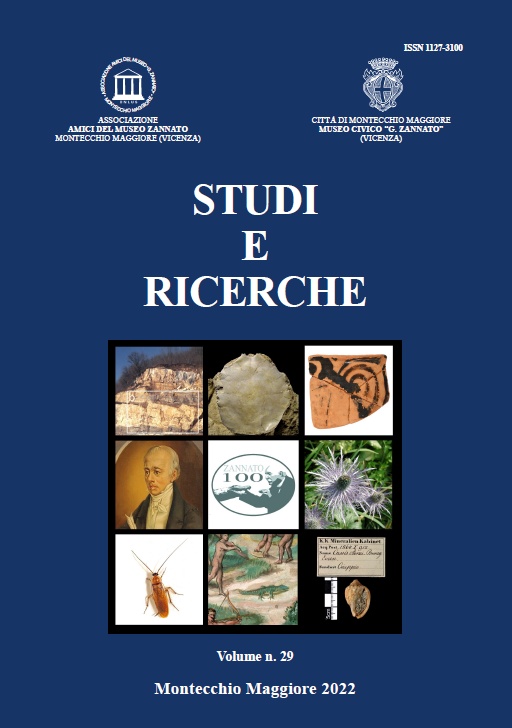Since 1994, the museum has published its own scientific journal, Studies and Research, as well as a number of monographs and articles of a naturalistic or archaeological nature.
The Editorial Board annually evaluates the publication of contributions of high scientific value. Unpublished works concerning topics within the field of natural sciences and archaeology are considered for publication, with preference given to those concerning the Veneto region and in particular the Vicenza area; a maximum of 2 articles per Author/Co-Author can be published.
The papers are first evaluated by the Editorial Board of the Journal, which submits them for peer review by external experts: articles that do not respect the relevance of the journal or are manifestly far from the quality standards of the Journal may be directly rejected by the Editorial Board. There is no cost to Authors for publication.
Download here the Authors’ Guidelines
COMPLETE VOLUMES:

Articles Database
You can search and browse all works produced by the museum here, using tags or search or by scrolling through the catalog by year of publication.
2024
Zampieri D
Un’introduzione settecentesca all’Antropocene. Il Quaternario nelle ricerche di Giovanni Arduino Journal Article
In: Associazione Amici del Museo - Museo Civico “G. Zannato”, vol. 31, pp. 67-74, 2024, ISSN: 1127-3100.
Abstract | Links | BibTeX | Tags: Agno Valley, Anthropocene, Giovanni Arduino, Quaternary
@article{Zampieri2024,
title = {Un’introduzione settecentesca all’Antropocene. Il Quaternario nelle ricerche di Giovanni Arduino},
author = {Dario Zampieri},
editor = {Associazione Amici del Museo - Museo Civico “G. Zannato”},
url = {undefinedhttps://www.museozannato.it/wp-content/uploads/2025/06/10_Dario-Zampieri.pdf},
issn = {1127-3100},
year = {2024},
date = {2024-12-31},
journal = {Associazione Amici del Museo - Museo Civico “G. Zannato”},
volume = {31},
pages = {67-74},
abstract = {Nel corso dell’anno 2024 sono avvenuti due eventi importanti per la Storia delle Scienze della Terra, tra loro collegati dalla definizione dell’unità cronostratigrafica detta Quaternario. Il primo è la votazione negativa della Commissione Internazionale di Stratigrafia (ICS) sulla proposta di formalizzazione di una nuova epoca chiamata Antropocene, quale ultima epoca del periodo Quaternario. Il secondo è la promozione della Valle dell’Agno a sito n. 101 della lista del patrimonio geologico dell’Unione Internazionale di Scienze Geologiche (IUGS) per la categoria Storia delle Geoscienze. Proprio nella Valle dell’Agno, a metà Settecento lo scienziato Giovanni Arduino, veronese di nascita ma vicentino di adozione, disegnò una sezione geologica che ispirò la suddivisione geocronologica del tempo profondo tuttora in vigore, incluso il Quaternario. Entrambe le unità cronostratigrafiche Quaternario e Antropocene sono state e continuano ad essere oggetto di accese discussioni tra i geologi.
Parole chiave: Antropocene, Quaternario, Giovanni Arduino, Valle dell’Agno.
ABSTRACT
An Eighteenth-Century introduction to the Anthropocene. The Quaternary in Giovanni Arduino’s research on the Agno valley
During the year 2024, two important events occurred in the History of Earth Sciences, linked by the definition of the chronostratigraphic unit called the Quaternary. The first is the rejection from the International Commission on Stratigraphy (ICS) of the proposal of the formalization of a new epoch called Anthropocene, as the last epoch of the period Quaternary. The second is the promotion of the Agno Valley to a 101st site of the International Union of Geological Sciences (IUGS) Geological Heritage Site list for the History of Geosciences. Just in the Agno Valley, in the mid-eighteenth century the Veronese scientist Giovanni Arduino drew a geological section that inspired the geochronological subdivision of deep time still in effect today, including the Quaternary. Both Quaternary and Anthropocene chronostratigraphic units have been and continue to be hotly debated among geologists.
Key words: Anthropocene, Quaternary, Giovanni Arduino, Agno Valley.},
keywords = {Agno Valley, Anthropocene, Giovanni Arduino, Quaternary},
pubstate = {published},
tppubtype = {article}
}
Parole chiave: Antropocene, Quaternario, Giovanni Arduino, Valle dell’Agno.
ABSTRACT
An Eighteenth-Century introduction to the Anthropocene. The Quaternary in Giovanni Arduino’s research on the Agno valley
During the year 2024, two important events occurred in the History of Earth Sciences, linked by the definition of the chronostratigraphic unit called the Quaternary. The first is the rejection from the International Commission on Stratigraphy (ICS) of the proposal of the formalization of a new epoch called Anthropocene, as the last epoch of the period Quaternary. The second is the promotion of the Agno Valley to a 101st site of the International Union of Geological Sciences (IUGS) Geological Heritage Site list for the History of Geosciences. Just in the Agno Valley, in the mid-eighteenth century the Veronese scientist Giovanni Arduino drew a geological section that inspired the geochronological subdivision of deep time still in effect today, including the Quaternary. Both Quaternary and Anthropocene chronostratigraphic units have been and continue to be hotly debated among geologists.
Key words: Anthropocene, Quaternary, Giovanni Arduino, Agno Valley.